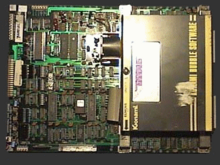Magnetic bubble memory
A magnetic bubble memory is a type of computer - data storage , in which a thin film of magnetizable material is used (in which small magnetic domains, the so-called bubbles English Bubbles ) are located. Each of these bubbles stores one bit of data. The magnetic bubble memory was considered a promising technology in the 1970s, but soon fell behind hard drives commercially in the 1980s .
Prehistory: Twistor memory
The magnetic bubble memory is essentially the brainchild of one person, Andrew Bobeck . Bobeck had worked on various projects related to magnetism in the 1960s, two of which predestined him for the development of magnetic bubble memory. These were the magnetic core memory system, which was controlled by a transistor- based controller , and the Twistor memory.
Twister memory is based on magnetostriction , an effect by which magnetization patterns can be moved. If such a pattern is stored, for example, on magnetic tape through which an electric current is subsequently passed, the pattern as a whole moves in the direction of current flow. By placing a detector at a point above the tape, the stored information can be read out successively without the tape physically moving. The Twistor memory is therefore an immovable analogue of the drum memory . In the 1960s, the American company AT&T used the twist memory in a number of devices.
In 1967, Bobeck joined a development team at Bell Laboratories and began working on improvements to the Twistor memory. His goal was to use a material in which magnetization patterns can only move in one direction to construct a 2D version of the twist memory. The patterns should be written on one side of the material and then moved electrically like in the twist memory. Because of the directional movement while the formation of tracks would (tracks) to be expected.
Magnetic bubbles
Bobeck started his search for materials with orthorite . He noticed an interesting effect: If you apply an external magnetic field to a magnetization pattern in this medium, the area contracts into a small circle, which Bobeck called a bubble . These bubbles were much smaller than the magnetization domains of normal storage media such as magnetic tape, so that much higher storage densities appeared possible.
After a long period of experimentation, garnet turned out to be endowed with the best properties. The bubbles formed easily and were mobile. However, it remained difficult to move them specifically to the location of the detector to read out the data. In contrast to the one-dimensional twister memory, two dimensions were now available, and the lateral movement of the bubbles was the problem. The solution was to apply a pattern of small magnetizable fields to the garnet surface. When a weak magnetic field was applied, they became magnetic and the bubbles “stuck” to one end. By reversing the field, the bubbles are transported to the other end, by reversing again to the next field in line.
A storage unit consists of a row of small electromagnets as write heads at one end of the storage layer and detectors at the other end. Inscribed bubbles slowly migrate from one end to the other, forming adjacent layers of twistor elements. If the output of the detectors is fed back to the write heads, a cycle results in which the information can be stored for any length of time.
History and Applications
The magnetic bubble memory is a non-volatile memory . Even if the power is turned off, the bubbles remain, as do the magnetization patterns on a hard drive. Another advantage is the lack of mechanically moving parts. Due to the small size of the bubbles, a high information density can be achieved. A disadvantage, however, is the low readout speed (access time approx. 500 microseconds). The information cannot be read until the bubbles have migrated to the detector.
Bobeck's team was soon able to store 4,096 bits per square centimeter, which corresponded to the storage density of the core memory common at the time . This has generated significant industry interest. The magnetic bubble memory appeared to be an alternative to core, tape, and floppy disk storage. Magnetic bubble memory promised to replace all other types of memory except for the high-speed memory market.
Virtually every major electronics company was working on magnetic bubble memory in the mid-1970s. By the end of the decade, several versions were out, and Intel launched its own 1- mebibit version, the 7110 . In the early 1980s, however, magnetic bubble memory proved to be a dead end with the introduction of hard drives with higher information density and shorter access times. The development work was almost completely stopped. Only niche products, which depend on reliability under high mechanical stress (e.g. in the presence of strong vibrations), could still hold up.
One such application was the Konami Company's Bubble System video game system , introduced in 1984. It was based on removable magnetic bubble memory cartridge and a derivative of the Z80 - console . The games available included Gradius , Attack Rush / Hyper Crash / Hyper Crush, and TwinBee . The magnetic bubble memory system required a warm-up time of around 20 seconds, which was counted down on the screen before the game was loaded, as the memory can only be operated optimally at 30 to 40 ° C. The magnetic bubble memory system proved unpopular, and many games made for it were subsequently made for other video consoles using conventional ROM memory.
Web links
- Historical storage medium: Bladder accumulator - Illustrated functional description of the magnetic bubble accumulator
- The Arcade Flyer Archive - Konami Bubble System Flyer


